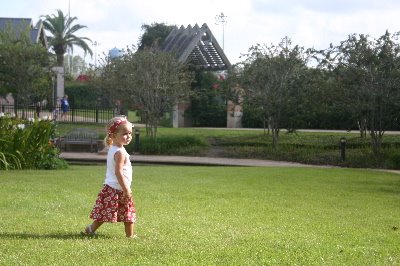It's terribly difficult to imagine Cinderella truly feeling like a princess in one of these squashes....but nonetheless, they bring our house great joy come this time of year. Growing up in a small town with lots of farming fields surrounding us, we found ourselves at an inumerable amount of pumpkin walks, pumpkin patches, corn mazes, haunted fields, etc., etc. .
Houston leaves much to be desired in that reguard, so when we heard of a nearby pumpkin patch last Saturday at the DC*, we decided it was a must! Ste and I took the kids and stayed and played for hours. Though nothing can live up to my own childhood memories, I was happy to know that my children were gaining theirs.

I learned the history behind the oh-so-famous Jack-O-Lantern and I'd thought I'd share it with any other urban myth/history fans.
People have been making jack-o-lanterns at Halloween for centuries. The practice originated from an Irish myth about a man nicknamed "Stingy Jack." According to the story, Stingy Jack invited the Devil to have a drink with him. True to his name, Stingy Jack didn't want to pay for his drink, so he convinced the Devil to turn himself into a coin that Jack could use to buy their drinks. Once the Devil did so, Jack decided to keep the money and put it into his pocket next to a silver cross, which prevented the Devil from changing back into his original form. Jack eventually freed the Devil, under the condition that he would not bother Jack for one year and that, should Jack die, he would not claim his soul. The next year, Jack again tricked the Devil into climbing into a tree to pick a piece of fruit. While he was up in the tree, Jack carved a sign of the cross into the tree's bark so that the Devil could not come down until the Devil promised Jack not to bother him for ten more years.

Soon after, Jack died. As the legend goes, God would not allow such an unsavory figure into heaven. The Devil, upset by the trick Jack had played on him and keeping his word not to claim his soul, would not allow Jack into hell. He sent Jack off into the dark night with only a burning coal to light his way. Jack put the coal into a carved out turnip and has been roaming the Earth with it ever since. The Irish began to refer to this ghostly figure as "Jack of the Lantern," and then, simply "Jack O'Lantern."

In Ireland and Scotland, people began to make their own versions of Jack’s lanterns by carving scary faces into turnips or potatoes and placing them into windows or near doors to frighten away Stingy Jack and other wandering evil spirits. In England, large beets are used. Immigrants from these countries brought the jack o’lantern tradition with them when they came to the United States. They soon found that pumpkins, a fruit native to America, make perfect jack o’lanterns.
 I LOVE the time change that occurs every Fall. Maybe that's even another reason why I love Autumn so much. My father always told me "only a fool wouldn't take advantage of this time change." I love this extra hour. Some years I'm much better at taking advantage of it than others, but I love it nonetheless. If only my children didn't also take advantage of it. I'd have a much easier time making it to the gym if they weren't awake at 6 am, too.
I LOVE the time change that occurs every Fall. Maybe that's even another reason why I love Autumn so much. My father always told me "only a fool wouldn't take advantage of this time change." I love this extra hour. Some years I'm much better at taking advantage of it than others, but I love it nonetheless. If only my children didn't also take advantage of it. I'd have a much easier time making it to the gym if they weren't awake at 6 am, too.





















